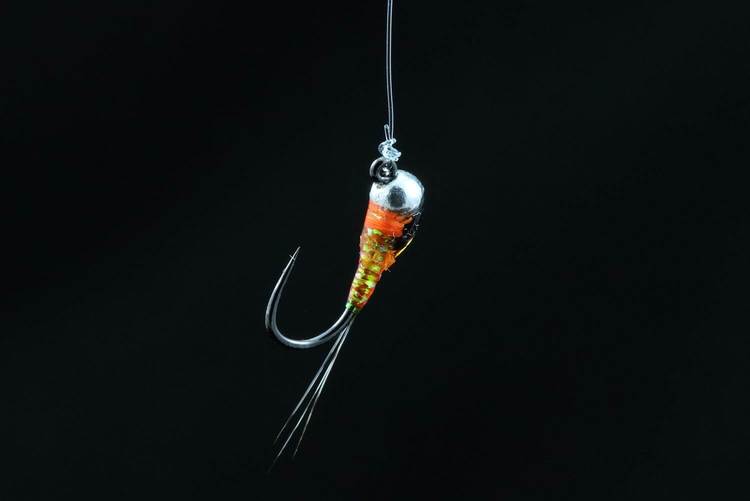
THE BENEFITS OF BARBLESS
Share
About five years ago, rumors were stirring that FIPS-Mouche was going to mandate the use of factory barbless hooks in competitions. Since 90% of my many thousands of flies were tied on crimped barbed hooks at the time, I was understandably daunted by retying my arsenal with factory barbless hooks. I had tried several early styles of competition inspired barbless hooks and I had been completely disheartened by their soft steel with points that would roll on a fish’s lip and completely fold on a rock. But wanting to be prepared, I set about searching for better barbless brands and models and I began to find them even though competition inspired hooks were still in their infancy this short time ago. Once I started tying on Hanak hooks, I realized I had been hampering my success and landing fewer fish by not making the conversion earlier. Since this time, many hook companies have made great strides in their quality and I am continuing to add good hooks to the Tactical Fly Fisher store as I come across them. However, you will notice some well-known competition barbless brands which I don’t stock because they continue to have poor steel and quality in my experience and I try to sell hooks I would be happy to fish myself.
At this point, it is still unclear whether crimped barbed hooks are allowed in FIPS-Mouche competitions since the current rule 29.8. states, “All flies must be dressed on barbless single hooks, tandem flies are not allowed.” The previous stipulation that hooks could be crimped barbless has been removed but there has not been a provision added stating that manufactured barbless hooks are required. In a discussion with FIPS president Paul Vekemans, while in Norway, he stated that crimped barbed hooks were still allowed though I have found other interpretations in talking to other FIPS officials. I believe some more descriptive language needs to be added to clear up the vagueness of this rule. Regardless, the benefits of competition inspired barbless hooks have been apparent enough for me that I won’t be switching back to barbed hooks down the road whether I’m competing or not. What are the benefits of competition inspired barbless hooks? In my view here are a few below.
1.Reducing physical damage and release times for fish
Back during graduate school when I had ready access to scientific journals, I did quite a bit of reading on hooking mortality and injuries to fish. It is true that barbed artificial flies only marginally increase single hooking event mortality over barbless flies (barbed fly mortality 3.88% vs 1.76% barbless fly mortality; Wright 1992). However, barbed flies increase unhooking times and drastically increase sub-lethal physical damage. As Meka (2004) wrote, concerning a high pressure rainbow trout fishery in Alaska, “…fishing methods and whether J hooks were barbed or barbless significantly influenced new overall injury rates. Fish caught by spin-fishing had similar injury rates as those caught by fly-fishing; thus, significance was from higher injury rates with barbed hooks for both fishing methods as well as higher injury rates for barbed hooks between fishing methods.” Where I live in Oregon I have the pleasure of fishing a lot of rivers that receive little trout fishing pressure. However, I am startled by how many trout I catch that are missing maxillaries or have other similar hooking injuries likely stemming from the intense fishing pressure these fish receive during steelhead season since Oregon does not stipulate barbless hooks while fishing for steelhead as surrounding states do. Even on a roadless hike in river I fished last Saturday, about 10% of the fish I caught were missing maxillaries. Pay attention next time you’re on the water and I wouldn’t be surprised if you see trout sporting an unnatural and sad looking smile. On many of the most popular rivers in the USA, it is hard to find a fish that doesn’t look used and abused. Look around on Instagram and Facebook and you’ll see smiling fish everywhere. If fisherman used barbless hooks more universally, we would have a lot fewer fish showing the negative effects, even if only aesthetic, of having a barb ripped out of their mouths. This is one of the many reasons I despise the phrase “ripping lips”. If we truly care about the fish we catch and release, we should be trying to leave them with as little evidence of our hooking them as possible.
A pretty rainbow that ate a Magneto Stone this winter. It would be much prettier had it not had its maxillary removed by a prior angler.
A stunning bull trout showing some significant maxillary damage from a previous angler.
2.Barbless hooks make it much less painful when you hook yourself or your fishing partner
We’ve all been in this situation. I remember leaving a large barbed Mustad uncrimped while fishing a brook trout lake well back into Utah’s Uinta range when I was 14. A nasty gust of wind shifted my hauled forward cast to the left a few inches and buried my damsel nymph into the back of my right ear cartilage. We were many miles from a trailhead and medical attention. When my dad tried and failed to rip the fly out of my ear it dropped me to my knees. I spent the next eight painful hours slowly working the barb through the cartilage of my ear until it could be crimped. Cartilage isn’t as soft as you think!
Another memorable instance came in my drift boat while guiding an endodontist and an orthodontist back in 2007. They crossed lines and of course one of them had a take during the drift and set the hook . All six flies (both were fishing dry double dropper rigs) came careening back at the boat in a heap and a Tungteaser became embedded in one of my client’s lips. Though his friend was used to having his hands in other people’s mouths all day, he was so distraught at having impaled his friend that I received the honor of the extraction. Since I hadn’t crimped the barb, he got to experience what it is like to lose some soft tissue. He was impressively stoic given it took a couple of tries with some hemostats. Both of the experiences detailed here could have been much easier if the hooks had been barbless.
A client of mine back in 2007 with a Tungteaser in his lip complete with a drop of blood. The smile faded understandably after having it ripped out.
3.Hook Penetration
This benefit has to do with simple physics. Believe it or not, trout have pretty hard mouths, especially as they get older and larger. A barb makes it much more difficult for a hook to penetrate. Accordingly, barbs result in a lot of missed fish on the hookset because of insufficient penetration; the typical couple of headshakes and gone scenario. Furthermore, because hook penetration is more difficult with barbed hooks, hooksets have to be harder which leads to a higher likelihood of breakoffs when setting the hook. I find that with barbless hooks and a long rod, it generally only takes a quick wrist flick to set the hook as long as I’ve kept the hook point sharp. Even the bump left from a crimped barb makes hook penetration more difficult and widens the insertion hole which makes it easier for the hook to pop out. While barbed hooks will keep more fish on the line when they are played poorly without proper tension, more fish will be hooked securely by barbless hooks in the first place so the number of fish to the net ends up being similar.
4.Hook loss after a breakoff
This benefit relates to benefit number one. It’s fairly common to catch fish with hooks in their mouths, or elsewhere, after breaking an angler’s line. Almost invariably, these hooks found in fish are barbed in my experience. Because barbed hooks do not require applied tension to stay in a fish, they often become a piece of unwanted jewelry in a fish if the line or tippet is broken. They then often stay there until they rust out, which can take a loooonnnnggg time with the finishes on modern hooks. Depending upon where the hook is, it may impede feeding or other important bodily functions. Barbless hooks largely eliminate this issue because they tend to slide out fairly easily once pressure is eliminated. If you don’t believe me, try sticking them into some foam and see what happens when you shake or brush up against them.
5. Adding a bead to your flies
If you're tying a beadhead fly, chances are that you will have to crimp the barb to get the bead on the hook so you might as well fish hooks that are designed barbless in the first place and save yourself some time.
In the end, I assume we all want to catch fish and land most of the fish we hook. I believe most of us also want to take care of the resource we rely on as much as we can while simultaneously avoiding injury to ourselves. With the advent of today’s barbless hooks sporting shapes specifically tailored to increasing landing rates, we can do our part to reduce injury to released fish and ourselves without sacrificing the opportunity to see a fish grace our net before we slide it home.
Barbless is best!
Citations
Meka, Julie, M. 2004. The influence of hook type, angler experience, and fish size on
injury rates and duration of capture in an Alaskan catch-and-release rainbow trout
fishery. North American Journal of Fisheries Management 24:1309-1321.
Wright, Sam. 1992. Guidelines for selecting regulations to manage open-access
fisheries for natural populations of anadromous and resident trout in stream habitats.
North American Journal of Fisheries Management 12:517-527.




